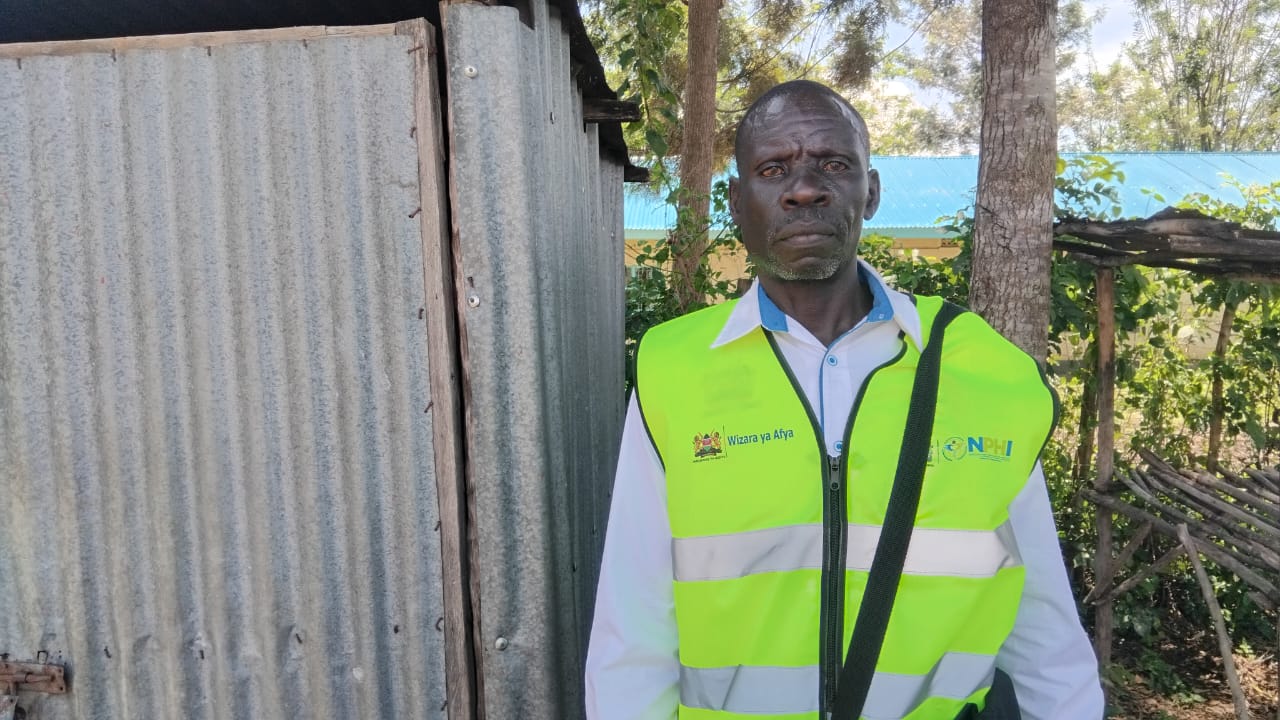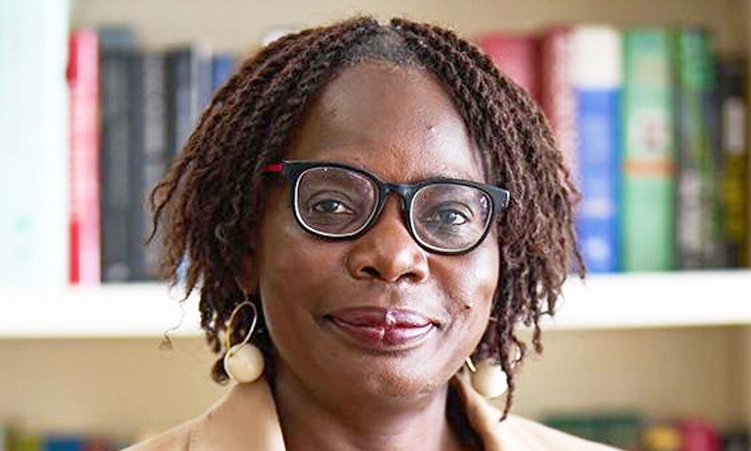 Paul Ochieng, a community health practitioner (CHP), in Ahero, Nyando Sub-County, Kisumu.
Paul Ochieng, a community health practitioner (CHP), in Ahero, Nyando Sub-County, Kisumu.
Paul Ochieng starts his days early at 6am. He is a rice farmer in Ahero. But his villagemates call him the community ‘doctor’, the title they give community health practitioners (CHP) here.
As a CHP, he carries a small backpack, a record book, a wooden measuring stick, and dons the signature blue or green reflector jacket.
Today, he is reminding parents to allow their children to attend a mass drug administration (MDA) exercise at the nearby Hongo Ogosa Health Centre in Ahero, Kisumu County.
“When I arrive at a homestead, I explain to each family what took me there. We have a request to allow the children to come for medicine (Praziquantel) to treat and prevent Aremo disease (Bilharzia), which causes people to urinate blood. This medicine is given to children from five to 15 years old,” he says.
By mid-morning, more than 100 children stand in line as he checks their height and hands out the bitter tablets, one by one. “They trust us because we also treat malaria, so they’re used to us.”
What Ochieng and several other CHPs are doing is part of a national effort to eliminate one of Kenya’s most stubborn diseases: bilharzia, also known as schistosomiasis.
“The first thing that makes Bilharzia a risk here in Ahero is that we have irrigation for rice growing,” he says, pointing to the paddies
stretching across the plain. “Many children go to weed the paddies when the
school is closed, and some contract this disease.”
 Evelyne
Adhiambo, a clinical officer, is the head of Hongo Ogosa Health Centre.
Evelyne
Adhiambo, a clinical officer, is the head of Hongo Ogosa Health Centre.
Bilharzia is one of the 17 neglected tropical diseases found in Kenya. These are infections that thrive quietly among the poor and rural communities, away from the spotlight of major epidemics. The parasite lives in freshwater snails and enters the body through the skin when people wade, bathe, or farm in contaminated water.
The worms grow inside the body and lay eggs that damage organs. Symptoms of the disease are caused mainly by the body’s reaction to the worms’ eggs.
The disease disables more than it kills. In children, schistosomiasis can cause anaemia, stunting and a reduced ability to learn. Chronic schistosomiasis may affect people’s ability to work and, in some cases, can result in death.
But because symptoms are often mild at first, few people notice that they are infected.
“Even though the impact of the disease is severe, the symptoms are not that pronounced and therefore it becomes a challenge for the infected person to seek treatment,” says Wyckliff Omondi, head of Neglected Tropical Diseases at the National Public Health Institute. He is also an assistant director of medical parasitology/entomology at the Ministry of Health.
The symptoms of chronic infection can take months or even years to appear and depend on the affected organ. The classic sign of urogenital schistosomiasis is blood in urine.
Omondi says 16 counties across Kenya are now affected, most around Lake Victoria, the coast, and parts of Eastern. The Ministry of Health estimates that two in every ten children in the endemic areas are infected. “The only current available intervention if you are infected with this disease is by use of medicine (praziquantel tablets). But if you are to ask over the counter for praziquantel, you will find very few pharmacies have it. So accessibility of the treatment is one of the challenges,” he says.
He says drug administration is both curative and preventive. It kills the parasite, thereby breaking transmission.
Evelyne Adhiambo, a clinical officer, is the head of Hongo Ogosa Health Centre. Her facility has seen fewer cases in recent years, thanks to the routine MDA campaigns.
“The cases have reduced; it’s not so much,” she said. “Because from the period I’ve been here, we’ve managed to identify only two cases that had a presentation of bloody urine. One was an adult and the other was a primary school child.”
“This mass drug
administration (MDA) needs to go on continuously for us to be able to reduce
Bilharzia completely. Our target is to have zero diagnoses at the facility
level for a period of one year,” Adhiambo said.
 Hong Chow (right), a member of the healthcare executive committee and Head of China and International at Merck, assists health workers during the mass drug administration exercise.
Hong Chow (right), a member of the healthcare executive committee and Head of China and International at Merck, assists health workers during the mass drug administration exercise.
According to the World Health Organization (WHO), more than 200 million people are infected with Bilharzia worldwide, 90 per cent of them in Africa. The WHO has a goal to eliminate the disease by 2030, and Kenya has committed to that target.
Since 2007, German-based drugmaker Merck has been working with the WHO to distribute praziquantel tablets, the recommended treatment for the disease, mainly in sub-Saharan Africa.
Dr Harald Nusser, Head of Global Health and Health Equity at Merck, who visited the mass drug administration exercise in Ahero, said they have donated more than two billion tablets since 2007.
He explained that the company is making the medicine easier for younger children. "Merck has also developed a pediatric version for preschool-age children, which is disposable tablets, which aren’t that bitter, which are easier. You dissolve them in water, and then you can drink them more easily,” he said.
The tablets will soon be made locally. “Universal Corporation (a Kikuyu Town-based drugmaker) is going to manufacture drug products for this pediatric version… so that in the next two years or so they can be produced at scale,” he said. “That will increase self-reliance of the country and also the continent in the end.”
Hong Chow, a member of Merck’s global healthcare executive
team, is equally optimistic but realistic about what it takes. “We do see that
the existing praziquantel is not very suitable for preschool children. The
tablet is very big for them to swallow… and also the taste of the tablet.
That’s why we are having a technology transfer with Universal Corporation, and
hopefully very soon, our pediatric formulation will be available for preschool
kids in Kenya.”
 Wyckliff Omondi, head of Neglected Tropical Diseases at the
National Public Health Institute. He is also an assistant director of medical
parasitology/entomology at the Ministry of Health.
Wyckliff Omondi, head of Neglected Tropical Diseases at the
National Public Health Institute. He is also an assistant director of medical
parasitology/entomology at the Ministry of Health.
The African Institute for Health and Development (AIHD), a local nonprofit, helps run the MDA campaigns in western and coastal Kenya.
“We’ve been implementing partners with End Fund since 2022 in Nyanza, five counties, and the coastal region, six counties,” said Dr Mary Amuyunzu-Nyamongo, an anthropologist and the head of AIHD. “Our role in the coastal and Lake Victoria region is mass drug administration for Bilharzia, also known as schistosomiasis, social mobilisation, and everything to do with ensuring that we run the treatment well.”
She added, “If you defecate in the open, you are basically propagating the disease. So our focus is on those three pillars, where we focus on behaviour change communication, we focus on WASH, and also we do treatment.”
Today’s campaign has treated more than 200 children. “Once we treat the children, we basically are hoping to interrupt transmission. However, if we don’t also treat the people at home, we may not be very successful,” she said.
Ochieng, the CHP, watched with gratification as the MDA exercise wrapped up. His voice was already hoarse from hours of calling out names and explaining the same message over and over. He distributed hundreds of tablets.
“When the government hired us as community health workers, they did a lot of training for us. They told us that this disease is real, but we will find a way to get rid of it by giving people medicine. It's happening now, there is no charge, it's free,” he said proudly.

















